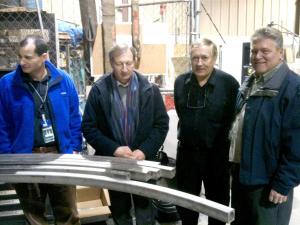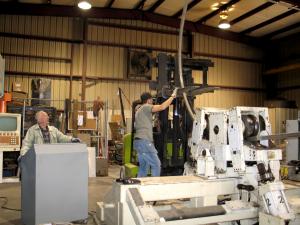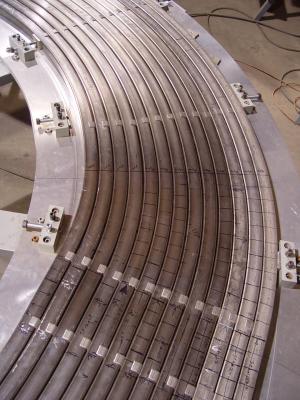Trial time for central solenoid
18 Feb 2011
-
Paul Libeyre, Central Solenoid & Correction Coil Section Leader
In front of the central solenoid conductor jacket bending trials, from left to right: Chris Rey (US-DA), Paul Libeyre (ITER), Charles Lyraud (ITER) and Wayne Reiersen (US-DA).
The ITER central solenoid is an essential part of the ITER magnet system, responsible for driving the current inside of the plasma. Procurement for the central solenoid will be shared between the Japanese Domestic Agency (JA-DA), in charge of conductor manufacture, and the US-DA, in charge of manufacturing the coils and associated structure.
In October 2010, the US-DA launched a call for tender to select a coil manufacturer, and the contract with industry is expected to be placed in spring 2011. In advance of manufacture, R&D actions are currently underway to address some of the more critical areas of this technically-challenging fabrication process (see below).
Nicolai Martovetsky (US-DA) monitoring a central solenoid conductor jacket winding trial. The winding tool pictured was originally used to wind the central solenoid model coil in the 1990s.
Mid-January, representatives of the ITER Organization paid a visit to the US-DA to review and discuss the available results of these ongoing actions.
Wayne Reiersen, Magnet team leader at the US-DA, presented the winding trials performed on empty central solenoid conductor jacket sections "within reasonably good accuracy" (above). This achievement was made possible by the use of a winding tool (left) that had formerly been used to wind the central solenoid model coil in the 1990s, refurbished by an industrial partner near Oak Ridge, Tennessee. The successful shaping of the turn joggle that provides transition from one turn to the next inside of a central solenoid pancake was also demonstrated (below).
Further trials are planned on the shaping of the conductor in the area where a sharp bend occurs as the conductor exits the winding-pack to reach the terminals. Preliminary trials have shown that bending the cable on a radius as small as 100 mm is achievable without too much deformation.
Background information on the central solenoid:
The ITER central solenoid is split into six coils called modules, stacked one on top of the other and inserted into the free space in the middle of the torus that is formed by the toroidal field magnets. In order to maximize the total flux available to generate and sustain the plasma current, the number of turns (553) in each central solenoid coil is designed to be as large as possible. At the same time, the maximum magnetic field on the conductor must remain within the 13 T limit, providing enough margin for the Nb3Sn conductor operating at 4.5 K. The inner radius of one central solenoid module is 1.3 m, its outer radius 2.1 m and its height 2.15 m. The conductor is a cable-in-conduit conductor, with a square outer cross-section of 49 mm x 49 mm and an inner circular cable diameter of 32.6 mm. As the unit length of such a conductor will not exceed 918 m, it will be necessary to wind six unit lengths of 918 m and one unit length of 613 m for each module and to connect them with joints in order to reach the 6.1 km needed for 553 turns. The accurate winding of such a thick conductor into multiple pancakes with 14 turns each is indeed a serious challenge that has not yet been demonstrated; at the time of the central solenoid model coil program, layer winding, and not pancake winding, was used.




